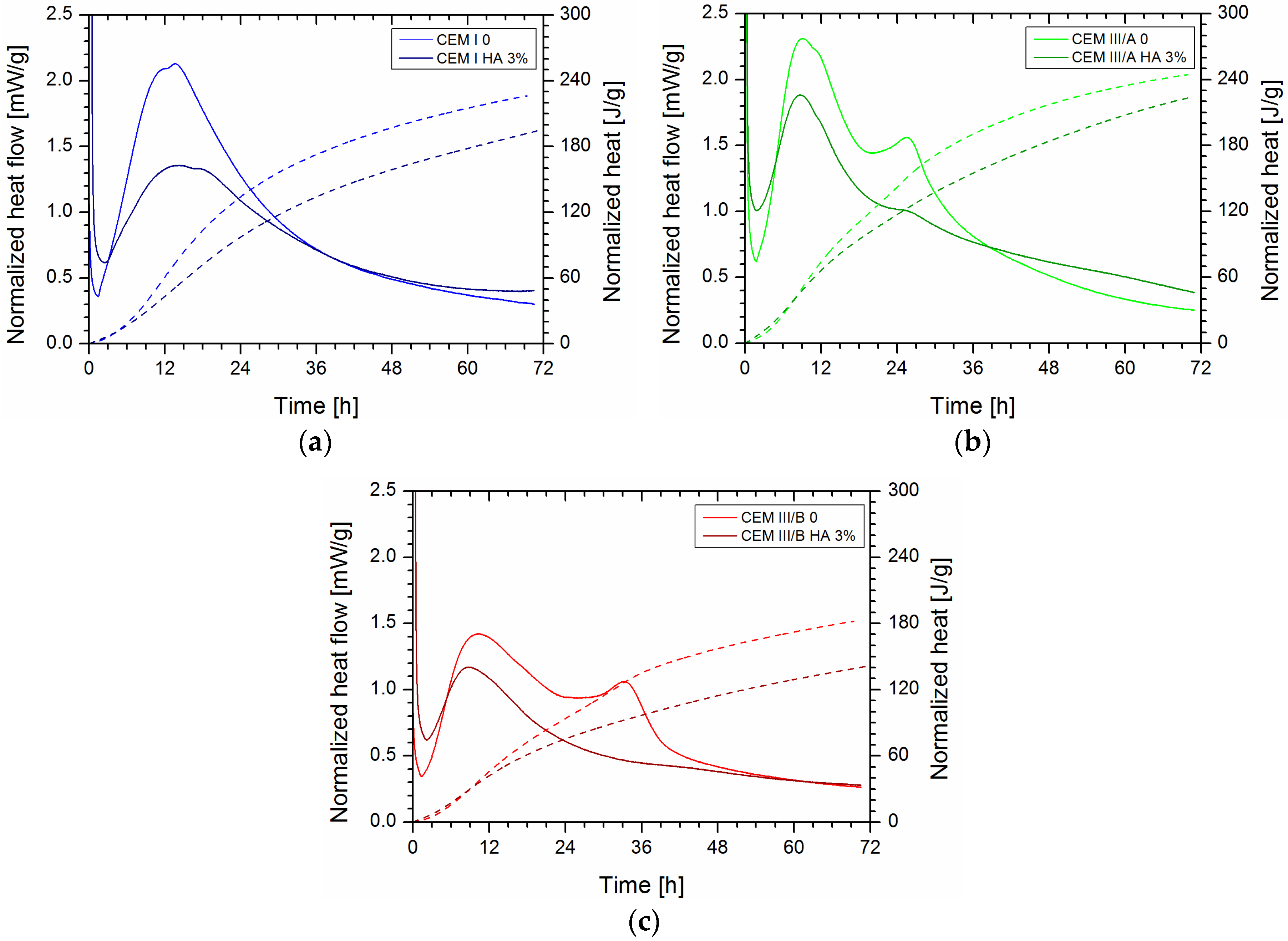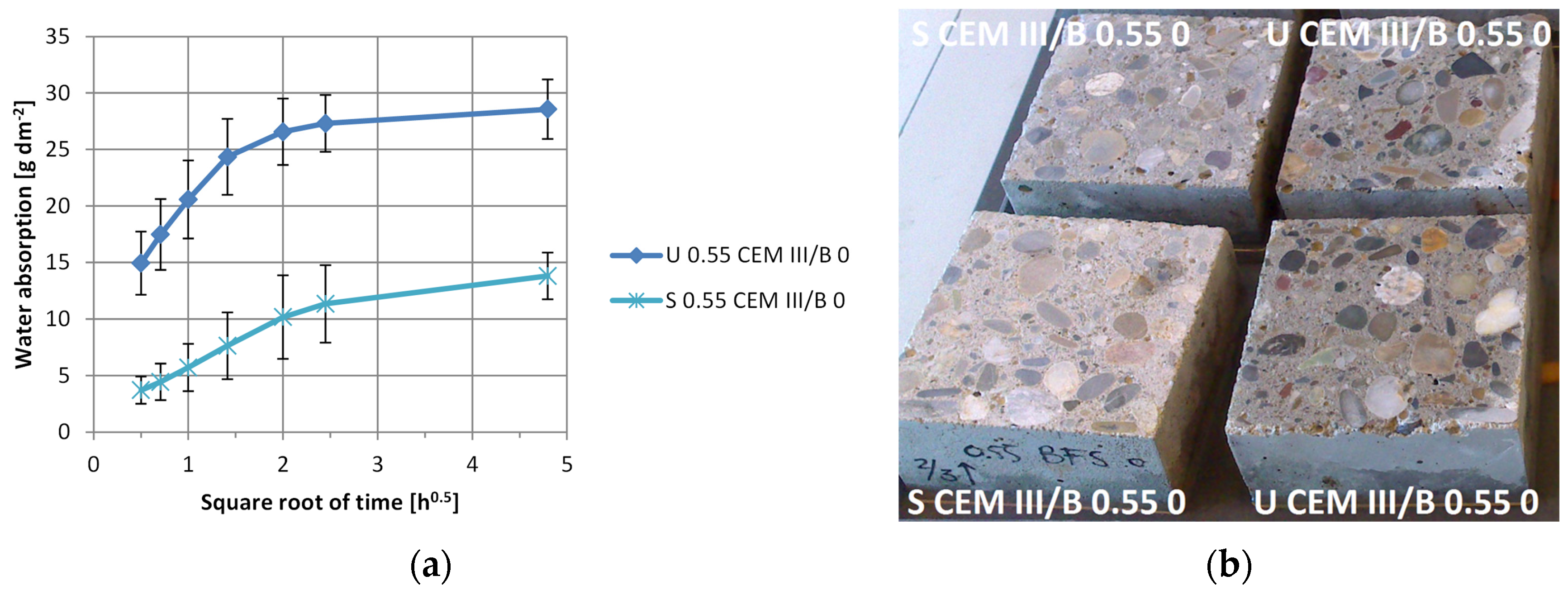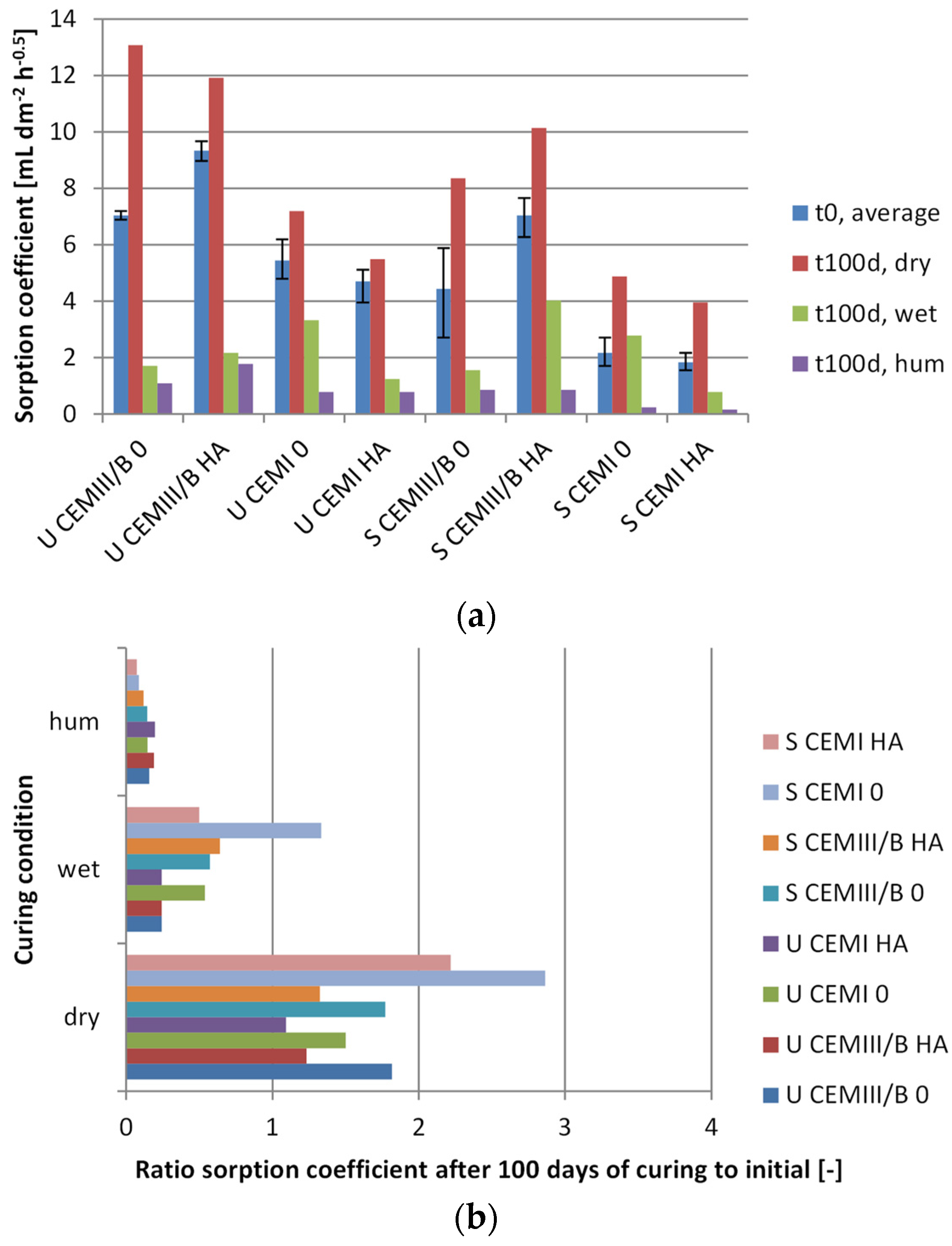Effect on Concrete Surface Water Absorption upon Addition of Lactate Derived Agent
Abstract
:1. Introduction
2. Materials and Methods
2.1. HA, Cement Paste and Concrete Material
2.2. Isothermal Calorimetry
2.3. Cube Compressive Strength
2.4. Capillary Absorption
3. Results
3.1. Isothermal Calorimetry
3.2. Cube Compressive Strength
3.3. Capillary Absorption
4. Discussion
5. Conclusion
Acknowledgments
Author Contributions
Conflicts of Interest
References
- Poursaee, A.; Hansson, C.M. Reinforcing steel passivation in mortar and pore solution. Cem. Concr. Res. 2007, 37, 1127–1133. [Google Scholar] [CrossRef]
- Ahmad, S. Reinforcement corrosion in concrete structures, its monitoring and service life prediction—A review. Cem. Concr. Compos. 2003, 25, 459–471. [Google Scholar] [CrossRef]
- Pease, B.J. Influence of Concrete Cracking on Ingress and Reinforcement Corrosion. Ph.D. Thesis, Technical University of Denmark, Lyngby, Denmark, September 2010. [Google Scholar]
- Song, H.W.; Lee, C.H.; Ann, K.Y. Factors influencing chloride transport in concrete structures exposed to marine environments. Cem. Concr. Compos. 2008, 30, 113–121. [Google Scholar] [CrossRef]
- Bouwmeester, W.J.; Schlangen, E. Influence of curing on the pore structure of concrete. In Tailor Made Concrete Structures; Walraven, J.C., Stoelhorst, D., Eds.; Taylor & Francis: London, UK, 2008; pp. 65–70. [Google Scholar]
- Parrott, L.J. Variations of water absorption rate and porosity with depth from an exposed concrete surface: Effects of exposure conditions and cement type. Cem. Concr. Res. 1992, 22, 1077–1088. [Google Scholar] [CrossRef]
- Chi, J.M.; Huang, R.; Yang, C.C. Effects of carbonation on mechanical properties and durability of concrete using accelerated testing method. J. Mar. Sci. Technol. 2002, 10, 14–20. [Google Scholar]
- De Ceukelaire, L.; Van Nieuwenburg, D. Accelerated carbonation of a blast-furnace cement concrete. Cem. Concr. Res. 1993, 23, 442–452. [Google Scholar] [CrossRef]
- Carvajal, A.M.; Maturana, P.; Pino, C.; Poblete, J. Analysis of the relation between accelerated carbonation, porosity, compressive strength and capillary absorption in concrete, in the search of a new control method by durability. J. Rev. Constr. 2009, 8, 129–135. [Google Scholar]
- Basheer, L.; Kropp, J.; Cleland, D.J. Assessment of the durability of concrete from its permeation properties: A review. Constr. Build. Mater. 2001, 15, 93–103. [Google Scholar] [CrossRef]
- De Rooij, M.; Van Tittelboom, K.; De Belie, N.; Schlangen, E. State-of-the-Art Report of RILEM Technical Committee 221-SHC: Self-Healing Phenomena in Cement-Based Materials, 1st ed.; Springer: Dordrecht, The Netherlands, 2013; pp. 1–18. [Google Scholar]
- Jonkers, H.M. Self healing concrete: A biological approach. In Self Healing Materials. An Alternative Approach to 20 Centuries of Materials Science; Van der Zwaag, S., Ed.; Springer: Dordrecht, The Netherlands, 2007; pp. 195–204. [Google Scholar]
- Jonkers, H.M.; Thijssen, A.; Muyzer, G.; Copuroglu, O.; Schlangen, E. Application of bacteria as self-healing agent for the development of sustainable concrete. Ecol. Eng. 2010, 36, 230–235. [Google Scholar] [CrossRef]
- Wiktor, V.; Jonkers, H.M. Field performance of bacteria-based repair system: Pilot study in a parking garage. Case Stud. Constr. Mater. 2015, 2, 11–17. [Google Scholar] [CrossRef]
- Mors, R.M.; Jonkers, H.M. Feasibility of lactate derivative based agent as additive for concrete for regain of crack water tightness by bacterial metabolism. Ind. Crops Prod. 2016. [Google Scholar] [CrossRef]
- Lanser, P.A.; Burger, A.M. Kooldioxide als een Stimulans voor Levenscyclusdenken in de Cement—en Betonindustrie; Cement & Beton Centrum: Hertogenbosch, The Netherlands, 2008. [Google Scholar]
- NEN-EN 196-1: 2005 Methods of Testing Cement–Part 1: Determination of Strength; Nederlands Normalisatie-instituut: Delft, The Netherlands, 2005.
- NEN-EN 206: 2014 Concrete–Specification, Performance, Production and Conformity; Nederlands Normalisatie-instituut: Delft, The Netherlands, 2014.
- NEN 8005 NL–Dutch Supplement to NEN-EN 206; Nederlands Normalisatie-instituut: Delft, The Netherlands, 2014. (In Dutch)
- NEN-EN 12390-3: 2009 Testing Hardened Concrete–Part 3: Compressive Strength of Test Specimens; Nederlands Normalisatie-instituut: Delft, The Netherlands, 2009.
- NEN-EN 12390-2: 2009 Testing Hardened Concrete–Part 2: Making and Curing Specimens for Strength Tests; Nederlands Normalisatie-instituut: Delft, The Netherlands, 2009.
- NEN-EN 1992-1-1: 2005 Eurocode 2: Design of Concrete Structures–Part 1–1: General Rules and Rules for Buildings; Nederlands Normalisatie-instituut: Delft, The Netherlands, 2005.
- NEN-EN 13057: 2002 Products and Systems for the Protection and Repair of Concrete Structures–Test Methods –Determination of Resistance of Capillary Absorption; Nederlands Normalisatie-instituut: Delft, The Netherlands, 2002.
- Singh, N.B.; Prabha, S.; Singh, A.K. Effect of lactic acid on the hydration of Portland cement. Cem. Concr. Res. 1986, 16, 545–553. [Google Scholar] [CrossRef]
- Holthuizen, P.E. Chloride Ingress of Carbonated Blast Furnace Slag Cement Mortars. Master’s Thesis, Delft University of Technology, Delft, The Netherlands, June 2016. [Google Scholar]
- Dias, W.P.S. Reduction of concrete sorptivity with age through carbonation. Cem. Concr. Res. 2000, 30, 1255–1261. [Google Scholar] [CrossRef]
- Gruyaert, E.; Robeyst, N.; De Belie, N. Study of the hydration of Portland cement blended with blast-furnace slag by calorimetry and thermogravimetry. J. Therm. Anal. Calorim. 2010, 102, 941–951. [Google Scholar] [CrossRef]





| Component | 0.55 CEM I (kg·m−3) | 0.55 CEM III/B (kg·m−3) | 0.50 CEM III/B (kg·m−3) |
|---|---|---|---|
| Cement | 315 | 334 | 350 |
| Water | 173.25 | 183.7 | 175 |
| Sand | 794 | 782 | 792 |
| Gravel | 1042 | 1027 | 1018 |
| Cement Type | HA 0% | HA 3% | HA 4% | HA 5% |
|---|---|---|---|---|
| CEM I | A | A | A | A |
| CEM III/B | A | A | A | A |
| CEM III/A | A | A | N/A | N/A |
| Cement Type | Sample | w/c | Compressive Strength (MPa) | |||
|---|---|---|---|---|---|---|
| 1 Day | 7 Days | 14 Days | 28 Days | |||
| CEM I | 0 | 0.55 | – | 25.94 ± 0.77 | 30.08 ± 0.84 | 33.37 ± 0.33 |
| CEM I | HA | 0.55 | – | 21.96 ± 0.93 | 28.87 ± 1.77 | 35.80 ± 0.47 |
| CEM III/B | 0 | 0.55 | – | 23.70 ± 0.48 | 29.96 ± 0.79 | 32.70 ± 0.14 |
| CEM III/B | HA | 0.55 | – | 9.60 ± 0.45 | 11.91 ± 0.47 | 17.25 ± 0.25 |
| CEM III/B | 0 | 0.50 | 5.55 1 | 24.76 1 | 33.45 1 | 38.92 ± 1.13 |
| CEM III/B | HA | 0.50 | 0.95 1 | 11.42 1 | 19.15 1 | 21.15 ± 0.30 |
| CEM I | HA/0 | 0.55 | – | 0.85 | 0.96 | 1.07 |
| CEM III/B | HA/0 | 0.50 | – | 0.41 | 0.40 | 0.53 |
| CEM III/B | HA/0 | 0.55 | 0.17 | 0.46 | 0.57 | 0.54 |
© 2017 by the authors. Licensee MDPI, Basel, Switzerland. This article is an open access article distributed under the terms and conditions of the Creative Commons Attribution (CC BY) license (http://creativecommons.org/licenses/by/4.0/).
Share and Cite
Mors, R.; Jonkers, H. Effect on Concrete Surface Water Absorption upon Addition of Lactate Derived Agent. Coatings 2017, 7, 51. https://doi.org/10.3390/coatings7040051
Mors R, Jonkers H. Effect on Concrete Surface Water Absorption upon Addition of Lactate Derived Agent. Coatings. 2017; 7(4):51. https://doi.org/10.3390/coatings7040051
Chicago/Turabian StyleMors, Renee, and Henk Jonkers. 2017. "Effect on Concrete Surface Water Absorption upon Addition of Lactate Derived Agent" Coatings 7, no. 4: 51. https://doi.org/10.3390/coatings7040051
APA StyleMors, R., & Jonkers, H. (2017). Effect on Concrete Surface Water Absorption upon Addition of Lactate Derived Agent. Coatings, 7(4), 51. https://doi.org/10.3390/coatings7040051





